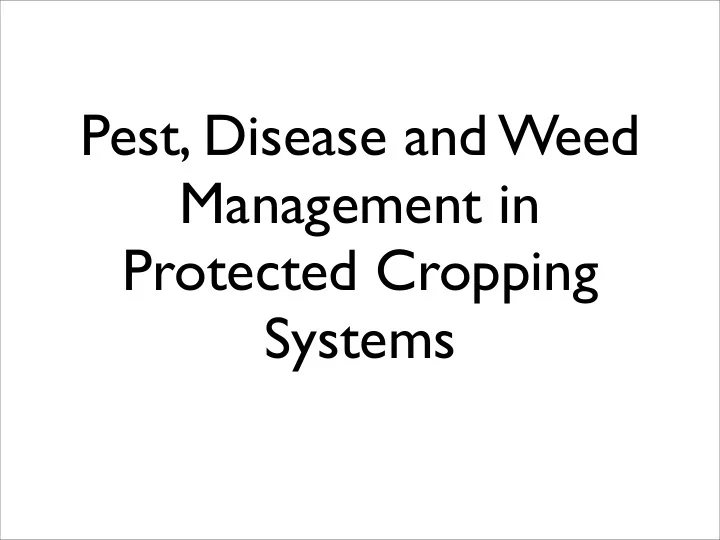

Pest, Disease and Weed Management in Protected Cropping Systems
Pests: Insects and Mites • Aphid (several species), Whitefly, Thrips, leafhopper, capsid bug, caterpillar and cut worm, scarid fly, root fly (carrot and cabbage), turnip saw fly, flea beetle, leaf weevil, leaf miner, spider mite. • Monitoring and correct identification is the key • Good biological control options • Soil and crop health, crop hygiene, biodiversity and correct seasonality, watering and climate control are vital
Prevention • Physical Barriers - insect mesh, air filters. • Preemptive biological agents • Biostimulants and deterrents. eg. Garlic • Encourage specific natural predators - provide habitat and hibernaculum, food and water. • Crop hygiene - clear debris and infested material, good housekeeping • Biodiversity - predator strips, nectar plants, mixed cropping, ecology of surrounding area.
Cure • Biological Agents - treat hotspots with non- flying predators, move predators to hotspots. • Bio-pesticides - Fungal (vertilec), nematodes (Steinernema feltiae), bacteria extract (Spinosad) • Pesticides - Soft soap/savona, pyrethrum, herb oils. • Hand picking (caterpillers), water blasting (spidermite), ant control
Pests: Slugs and snails • More of a problem in small polytunnels - migrate from damp edges. • Encouraged by moisture, ground cover, weeds and crop debris. • Discouraged by hot dry conditions and regular soil disturbance. • Use of nematodes and molluscicides considered less problematic under cover
Biological Control • The introduction of predatory and parasitic agents to control specific pest species. • Prevention is better than cure although requires a certain amount of foresight and faith. • Suited to protected cropping, highly mobile agents are less effective in mixed cropping systems. • Can be expensive, especially if used incorrectly - get advice on application and follow it. • See list for commonly used agents
Pests: Rodents and Birds • Existing barrier makes exclusion easier but not 100% (no room for complacency) • Rabbits and moles particularly problematic under ground cover! • Rats and mice on fruiting crops, encouraged by compost heaps and fertilisers. • Birds enjoy red fruits and may consume large numbers of beneficial insects. • Controls include traps, bait, dogs and cats.
Pests: 2 case studies • Aphid on spring lettuce - Start with strong clean plants avoiding prone varieties such as cos, cover with netting after planting, monitor and use vertilec if required, use A. colemani as a background parasitoid. Encourage natural ladybird population. • Spider mite on Aubergine - use Amblyseius californicus, it also controls thrips and is more effective than P. persimilis. Apply to tips every 2 weeks at a minimum average of 6-7 per plant. Damp down plants in the morning during hot weather.
Disease: Fungal Pathogens • Grey Mould (Botritis) - most crops, infects wounds and weak plants, encouraged by cool, humid conditions with poor air circulation. Air borne spores spread easily. • Sclerotinia - localised on cucurbits, beans and lettuce though can effect other crops, mainly effects weak and dying plants, encouraged by... (see above), discouraged by rotation and hygiene • Wilts - Fusarium and Verticillium, cucurbit and solanacae, worsening symptoms with age, hot and dry conditions. Spread through crop. Rotate and avoid watering close to the stem base.
Disease: Fungal Pathogens • Downey Mildew - Lettuce (Bremia), Spinach (Peronospora), Parsley. Remove infected material, use resistant cultivars, maintain spacing within crop. • Powdery Mildew - Cucumber/courgette, Tomato, Leaf beet, strawberries. Resistant cultivars and diligent control of humidity and watering is helpful. • Tomato Blight (phytophthora infestans) - usually brought in with rain in late summer, can also splash up from soil. Prevent leaks from roof and maintain good air flow. Meticulously remove infected material.
Disease: Bacterial • Soft Rot - common and widespread, enters where damage has already occurred e.g. Root fly • Cucumber Canker - avoid wet roots • Leaf spots (Pseudomonas) - lettuce and cucumber, caused by careless/overwatering
Disease: Viral • TMV, CMV, TSWV, CGMV, PMV, LMV, watch this space! • Transfered by ‘vectors’ leaf sucking insects, and picking/crop maintenance ie. transfer of sap. • Overwinter in living tissue - seeds and hosts (weeds) • No treatment, use resistant cultivars, encourage good crop health, hygiene and pest control. Remove and destroy infected material. Clean / sterilize picking tools.
Weed Control • To cover or not to cover? • Dripper pipes can make crops difficult to weed so work well in conjunction with ground cover. • Ground cover also helps to conserve moisture but can provide protection for soil pests. • Having control over irrigation means stale seed beds, flame weeding and hoeing can be more effective than outdoors. • 1 years seeding, 7 years weeding
Woven Polypropylene • Mypex / Permatex plastic, permeable, blackout ground cover in various sizes. Cheapest is 2m x 100m roll. Budget quality is fine. • Holes can be burned with a plumbers gas torch, also good for sealing frayed edges to prolong life. • Can be used for 12 years + • Work out spacings that can be used for several crops to get good use and reduce disease transfer • Concertina rather than roll - easier to unfurl.
Using Irrigation for weed control • During warm weather a well watered bed will have a rapid flush of weeds which can be flamed off before sowing. Another pre emergence flame, then allowing the bed to dry can give good control. • Once seedlings have emerged a good soak can result in ‘capping’ inhibiting further weed growth. • Allow hoed weeds to desiccate properly before watering.
Basic rules • Avoid letting pernicious weeds set seed. • Be aware of labour considerations, weed pressure is highest when the workload is heaviest. • Consider ways of controlling weeds in green manures. • Control seed dispersal around doors and ensure compost is clean as possible.
Recommend
More recommend